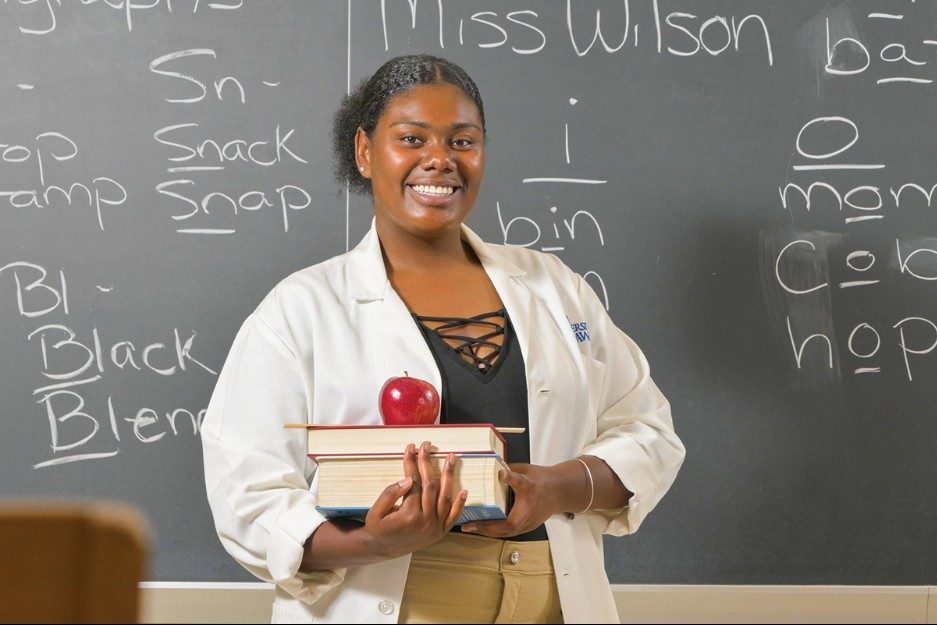Reimagining Residency

UD Brings a Medical Model To The Classroom
In August 2023, Anij’ya Wilson, EHD23, brimmed with excitement and confidence as she prepared her first-grade classroom at Evan G. Shortlidge Academy in Wilmington, Delaware. She had just graduated from University of Delaware’s elementary teacher education program, but she already had a full year of teaching experience under her belt.
Wilson served as a resident through UD’s relatively new Teacher Residency program, housed within the College of Education and Human Development’s Center for Excellence and Equity in Teacher Preparation. In partnership with three high-need school districts in Delaware and funded by the Delaware Department of Education, the program adapts the medical model of residency by allowing early childhood education, elementary teacher education and secondary STEM education students to pursue yearlong, paid placements in Delaware schools in lieu of a traditional student teaching experience.
The innovative, yearlong model gives UD students like Wilson an immersive, comprehensive teaching experience, offering opportunities for guided practice in the classroom and a gradual increase in teaching responsibility. It also allows them to forge meaningful connections.
“You learn how to build relationships, you learn how to maintain them, and you start to figure out who you are as a teacher and your teaching style,” Wilson says.
Importantly, the residency program also addresses critical issues in education across the state.
Addressing Delaware’s Teacher Shortage
Wilson’s experience illustrates the profound impact one teacher can have on a child’s development and underscores the critical need for more highly-qualified teachers.
The COVID-19 pandemic exacerbated a national teacher shortage, as school districts have struggled to staff their schools for nearly 15 years. Between 2010 and 2018, student enrollment in teacher preparation programs declined 35% nationally, and 60% in Delaware.
But, by requiring residents to teach in a high-need Delaware district for three years after the completion of their tenure, UD’s Teacher Residency Program helps to alleviate the issue. Since 2021, when the program launched, UD has graduated 55 residents, all of whom now teach in Delaware schools.
“I’m extremely happy because all of the residents that we had last year are now members of the Appoquinimink School District as teachers of record,” says Dominic Banks, director of talent acquisition and strategic staffing for the district. “We’re looking at the residency program as one of our pipelines, allowing participants to go from teacher resident to teacher of record.”
And, as noted by Kristina Najera, director of UD’s Center for Excellence and Equity in Teacher Preparation, residency may contribute to retention. “Because our residents have had such an intensive, comprehensive experience, we think they’re more likely to be the individuals that advance in the profession and rise to the teacher leadership role.”
Moreover, Delaware’s teacher workforce has struggled to reflect the increasing diversity of the state’s student body. In 2023, more than 59% of the pre-K through 12th-grade demographic identified as members of historically underrepresented groups, but only about 19% of Delaware teachers identified similarly.
But, in the coming years, UD plans to reserve half of its residency placements for students from historically underrepresented groups. So far, 24% of UD’s former residents identify as members of underrepresented groups.
The program complements other UD initiatives to diversify the education workforce, like the signature Teachers of Tomorrow (TOT) program, which introduces underrepresented, Delaware high schoolers to the field of education through a two-week summer institute where they can learn about degree programs and future careers. Wilson was a participant and the very first TOT student to earn her bachelor’s degree.
“A great deal of research shows that teachers prepared in such teacher preparation programs stay in the teaching profession longer and that their students have better outcomes,” says Gary T. Henry, dean of UD’s College of Education and Human Development. “The TOT and residency programs are key components of this preparation, especially for students from underrepresented backgrounds. Our residents are uniquely ready to enter their own classrooms with the skills and confidence to develop the relationships that support student learning and wellbeing.”
An Immersive, Comprehensive Experience
The residency program differs significantly from a traditional student teaching experience. That more traditional model, which typically includes two 7- to 14-week placements, may land one student in multiple schools and districts.
In contrast, the residency program offers a yearlong experience within one classroom. Students gradually accept teaching responsibilities as they work closely with a UD coach and an experienced mentor teacher, who provide guidance throughout the year. Residents also receive feedback from district personnel and UD staff, and they’re invited to participate in the school’s biweekly professional learning communities. At Red Clay Consolidated School District’s Forest Oak Elementary School, Wilson “felt such a community with my faculty members.”
She also honed critical skills in lesson planning, classroom management and more.
“If I didn’t have this whole year of relationship-building and classroom experience, I would be thinking, ‘Oh my gosh, how am I going to set up a classroom? I’ve never done this before.’ Whereas, because of my residency, I’ve already been through that process,” Wilson says.
She also remembers an especially poignant moment when a reserved child who came to her class with traumatic experiences told her that he would miss her at the end of the year.
“It was in that moment that I realized: I built this relationship, I did a good job and this child gave me [their] trust,” Wilson says. “That gave me a lot of encouragement. I know now that I can build relationships. It’s going to take time, but I did it with one. Imagine all the children I could reach now, each school year.”
Read this story on UD Magazine.
Article by Jessica Henderson.



